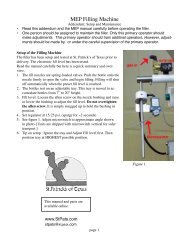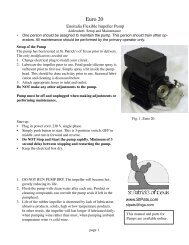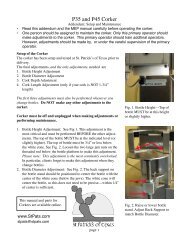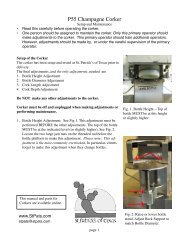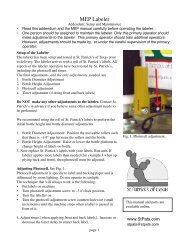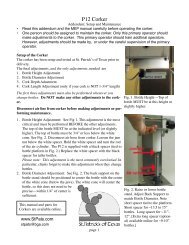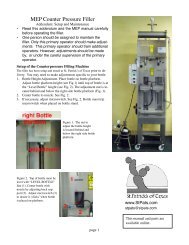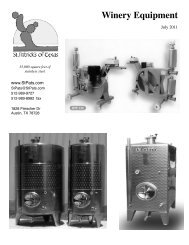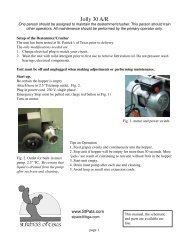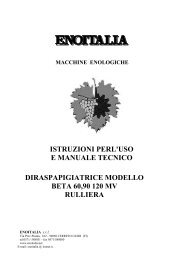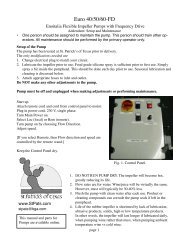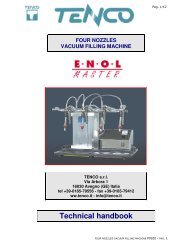P35 and P45 Corker - St. Patrick's of Texas
P35 and P45 Corker - St. Patrick's of Texas
P35 and P45 Corker - St. Patrick's of Texas
- No tags were found...
Create successful ePaper yourself
Turn your PDF publications into a flip-book with our unique Google optimized e-Paper software.
••<strong>P35</strong> <strong>and</strong> <strong>P45</strong> <strong>Corker</strong>Addendum: Setup <strong>and</strong> MaintenanceRead this addendum <strong>and</strong> the MEP manual carefully before operating the corker.One person should be assigned to maintain the corker. Only this primary operator shouldmake adjustments to the corker. This primary operator should train additinal operators.However, adjustments should be made by, or under the careful supervision <strong>of</strong> the primaryoperator.Setup <strong>of</strong> the <strong>Corker</strong>The corker has been setup <strong>and</strong> tested at <strong>St</strong>. Patrick’s <strong>of</strong> <strong>Texas</strong> prior todelivery.The final adjustments, <strong>and</strong> the only adjustments, needed are.2.3.4.Bottle Height AdjustmentBottle Diameter AdjustmentCork Depth AdustmentCork Length Adjustment (only if your cork is NOT 1-3/4”length)The first three adjustments must also be performed whenever youchange bottles. Do NOT make any other adjustments to thecorker.<strong>Corker</strong> must be <strong>of</strong>f <strong>and</strong> unplugged when making adjustments orperforming maintenance.Fig. 1. Bottle Height---Top <strong>of</strong>bottle MUST be at this heightor slightly higher..2.Bottle Height Adjustment: See Fig 1. This adjustment is themost critical <strong>and</strong> must be performed BEFORE the other adjustments.The top <strong>of</strong> the bottle MUST be at the indicated level (orslightly higher). The top <strong>of</strong> bottle must be 3/4” or less belowthe white cone. See Fig. 2. Loosen the two large jam nuts on thethreaded rod below the bottle platform to make this adjustment.Please note: This adjustment is the most commonly overlooked.In particular, clients forget to make this adjustment when theychange bottles.Bottle Diameter Adjustment: See Fig. 2. The back support onthe bottle st<strong>and</strong> should be positioned to center the bottle with thecenter <strong>of</strong> the white cone (below the jaws). The white cone willcenter the bottle, so this does not need to be precise---within 1/4”<strong>of</strong> center is sufficient.This manual <strong>and</strong> parts for<strong>Corker</strong>s are available online.www.<strong>St</strong>Pats.comstpats@stpats.comFig. 2. Raise or lower bottlest<strong>and</strong>. Adjust Back Support tomatch Bottle Diameter.page
3. Cork Length Adjustment: The corker has been setup for 45 mm(1-3/4”) cork length. You need to perform this adjustment ONLYif you are using 2” cork. See Figure 3. Note the gap betweenthe top <strong>of</strong> the cork <strong>and</strong> the cork descent tube. Position the corkdescent tube such that this gap is about 3/8”. Do not open thesnapper plastic clamp. Simply twist <strong>and</strong> push upward on the corkdescent tube (while pushing down on the snapper plastic clamp).4. Cork Depth Adjustment: Make this adjustment AFTER the BottleHeight Adjustment. The Bottle Height MUST be correct in orderto properly make this adjustment. Raise <strong>and</strong> lower the cork pushingpin (Fig. 4) to adjust the depth <strong>of</strong> the cork in the bottle.Fig. 3. Adjust Cork Descent Tubeif Cork Length is NOT 1-3/4”Periodic Maintenance. Keep Top Plate clean. See Fig. 5. Wipe the top plate with cle<strong>and</strong>amp cloth daily or as needed to keep cork dust to minimum.Windex or mild soap solution works well.2. <strong>P35</strong> only: See Fig. 6. Check oil level in vacuum pump daily(oil level can be seen through the outer cover with a flashlight).Optimum level is midway in window. Remove plug on top right<strong>and</strong> fill with quality vacuum pump oil as needed. Change oil annually.Fig. 4. Adjust Cork Pushing Pinto change depth <strong>of</strong> cork in bottle.ONLY MAKE THIS ADJUST-MENT AFTER BOTTLEHEIGHT ADJUSTMENT.FIG. 5. Keep Top Plate clean.Fig. 6. <strong>P35</strong> Vacuum Pump.Check oil level daily. Fill tomid-level in window.page
3.4.5.<strong>P35</strong> Solenoid Valve (<strong>and</strong>some older models <strong>of</strong> <strong>P45</strong>).See Fig. 7 <strong>and</strong> Fig. 8. [Solenoidvalve is mounted on leftside, at same height as thebottle platform.] Periodicallyremove solenoid valve stem<strong>and</strong> clean <strong>and</strong> lubricate.Grease Jaws periodically. Besure unit is <strong>of</strong>f <strong>and</strong> unplugged.Apply food gradegrease to the jaws throughopening in top plate. Simplydab with finger. Run unitseveral times without cork.Now, run several cork thrucorker to remove excessgrease. Also, apply smalldab <strong>of</strong> grease between corkpusher <strong>and</strong> post.Lubricate moving parts annually.See Fig. 9 <strong>and</strong> Fig.10. Remove front <strong>and</strong> backcovers. Lubricate all movingparts. Aerosol spray <strong>of</strong>lithium grease works well.Fig. 7. <strong>P35</strong> Solenoid Valve. Removenut, casing, <strong>and</strong> then valvestem.Fig. 8. Valve <strong>St</strong>em removed.Clean the rubber-tipped end <strong>and</strong>inside valve black as needed.Fig. 9. Front <strong>of</strong> corker. Lubricateall moving parts annually. Besure to lubricate the vertical rod(between the two large springs).The bottle platform moves onthis rod.Fig. 10. (Far right.) Back <strong>of</strong>corker.page
DO NOT.2.3.4.5.DO NOT use OZONE to clean a corker. Ozone will destroy all rubber <strong>and</strong> plastic components <strong>and</strong>should NEVER be used on equipment with rubber or plastic components.DO NOT use a HOSE or PRESSURE WASHER to clean a corker. Simply wipe down with cle<strong>and</strong>amp cloth. Pressure washers should NEVER be used on equipment with bearings or electrical components.DO NOT use METABISULFITE (or any harsh chemicals) for cleaning or sanitizing. Metabisulfite isnot a sanitizer nor a cleaner <strong>and</strong> should NEVER be used as such. Metabisulfite is corrosive to mostmetals including stainless steel.DO NOT change any parameters <strong>of</strong> the inverter.DO NOT remove the jaws or make any adjustments to the corker except those on the previous pages.Contact <strong>St</strong>. Patrick’s in advance if you believe some other adjustment needs to be performed.Problems <strong>and</strong> SolutionsProblem: Nothing happens when you push the microswitch or start buttons.Solution 1: Emergency <strong>St</strong>op button is pushed in. Pull it out.Solution 2. One or both interlocks is open. Close lid on hopper to activate one interlock. Clear safetyshield must be in place to activate the second interlock.Problem: Cork not pushed into bottle far enough.Solution 1: BOTTLE HEIGHT IS TOO LOW. This is the most <strong>of</strong>ten misdiagnosed problem. Be certainthe BOTTLE HEIGHT IS CORRECT, THEN AND ONLY THEN ADJUST THE CORK PUSHINGPIN.Solution 2. Cork pushing pin is too high.Problem: Cork does not come down the cork descent tube.Solution: Small spring (Tap0008) inside hopper is broken. Replace spring. (available online).Problem: Solenoid valve sticks open, or will not open.Solution: Remove solenoid shaft <strong>and</strong> clean <strong>and</strong> lubricate. If necessary, disconnect tubing (push-in fittings)<strong>and</strong> flush solenoid body with compressed air.Problem: Bottle <strong>St</strong><strong>and</strong> does not move up <strong>and</strong> down correctly, or swings side to side easily.Solution: Large bottle st<strong>and</strong> springs (Tap0011) have broken. Replace the springs. (available online).[Note that the corker will operate fine with only one <strong>of</strong> the springs. These springs are part <strong>of</strong> the safetysystem to prevent bottle breakage.] To replace a spring. Hook bottom <strong>of</strong> spring first. Grab top <strong>of</strong> springbelow hook with needle nose pliers <strong>and</strong> pull upward. This requires a bit <strong>of</strong> strength.page
M.E.P. - operator's h<strong>and</strong>book - <strong>P45</strong> corking machineCONDITIONS OF SALE AND WARRANTY1. Read carefully this operator's h<strong>and</strong>book before operating our <strong>P45</strong> corking machine.2. M.E.P. guarantees his <strong>P45</strong> corking machine in case <strong>of</strong> breakages caused by faultycomponents or incorrect assembly.3. Our <strong>P35</strong> corking machine has a 12-month warranty. 12 month period begins on shipping datefrom <strong>St</strong>. Patrick’s <strong>of</strong> <strong>Texas</strong>. This guarantee is valid only for the first owner <strong>of</strong> thecorking machine.4. Warranty only consists in replacing the damaged parts <strong>and</strong> it does include neitherrefunds for losses caused by the shutdown <strong>of</strong> the machine nor any cost <strong>of</strong> labour orany transport cost to send the filling machine to a repair shop.5. Any repair or modification made to the machine by unauthorized personnel will makethe warranty void.6. We cannot be held responsible for damages due to incorrect use <strong>of</strong> the corkingmachine, or failure to carry out maintenance <strong>and</strong> lubrication, or problems or damageincurred during transport.7. M.E.P. reserves the right to introduce changes without previous notice to the <strong>P45</strong>corking machine; however, the supply <strong>of</strong> spare parts <strong>of</strong> the previous models will beguaranteed.INDEXDescription <strong>of</strong> the <strong>P45</strong> corking machine........................................... page 2Operating directions..........................................................................................3Technical details ...............................................................................................4Instructions for use............................................................................................5Faults <strong>and</strong> remedies check list...........................................................................8Maintenance .....................................................................................................12Electric system <strong>of</strong> the <strong>P45</strong> corking machine......................................................13Components <strong>of</strong> the <strong>P45</strong> corking machine ..........................................................14Wheeled support D model - as optional equipment ...........................................161
M.E.P. - operator's h<strong>and</strong>book - <strong>P45</strong> corking machineDESCRIPTION OF THE <strong>P45</strong> CORKING MACHINEOur <strong>P45</strong> corking machine meets the requirements <strong>of</strong> those wine-growers who need arapid <strong>and</strong> precise corking.Our <strong>P45</strong> corking machine is almost entirely made <strong>of</strong> stainless steel to make cleaningeasier. Moreover all those parts which could come into contact with the corks are made<strong>of</strong> materials that do not react with the air (such as stainless steel, plexiglass, chromiumplatedsteel), in order to prevent all chances <strong>of</strong> polluting corks with rust splinters orwhatever other substances bad for health. Even the internal mechanisms, such asconnecting rods <strong>and</strong> levers, are galvanized. All the parts which come into contact withthe bottle are made either <strong>of</strong> rubber or pvc to avoid the breaking <strong>of</strong>f <strong>of</strong> splinters from theglass.All moving gears are protected by safety guards <strong>and</strong> those parts which the operatormust reach <strong>of</strong>ten, such as the cork container <strong>and</strong> the jaws, are fitted up with easilyremovable safety guards. The latter are equipped with a sensor so that the corkingmachine cannot work when these guards are removed.SAFETY SYMBOLS:General dangerCaution: refer to the operator's h<strong>and</strong>book2
M.E.P. - operator's h<strong>and</strong>book - <strong>P45</strong> corking machineCaution: 110 Volt tension.Caution: rotating gears. Severing <strong>of</strong> fingers.OPERATING DIRECTIONSOur <strong>P45</strong> corking machine is provided with an upper cork container which is fitted upwith a mechanical mixing device that lines the corks up <strong>and</strong> pushes them through thedescent duct for the corking to be carried out successfully. This corking machinepositions the cork within jaws which squeeze it down to the size <strong>of</strong> the neck <strong>of</strong> the bottle.In this way less stress is needed to push the cork down into the neck <strong>of</strong> the bottle with theadvantage <strong>of</strong> not damaging the cork itself that will exp<strong>and</strong> once it is inserted <strong>and</strong> ensure agood seal.To start the corking machine a bottle must be placed on the bottle platform, the twostarting push-buttons located on the sides <strong>of</strong> the machine must be kept pressedsimultaneously for a couple <strong>of</strong> seconds (see picture 1). In this way the working cyclestarts <strong>of</strong>f: the bottle platform goes up, the jaws go down <strong>and</strong> compress the cork which isafterwards inserted into the neck <strong>of</strong> the bottle by the cork-pushing pin (see picture 1).At this point the two push-buttons can be released to start the cycle <strong>of</strong> return <strong>of</strong>f. Thismeans the lowering <strong>of</strong> the bottle platform, the ascent <strong>of</strong> the cork-pushing pin <strong>and</strong> therotation <strong>of</strong> the cork pusher which picks up a cork from the cork descent duct <strong>and</strong> drives itinto the jaws ready to be used next time.3
M.E.P. - operator's h<strong>and</strong>book - <strong>P45</strong> corking machinePicture 1.TECHNICAL DETAILS<strong>St</strong><strong>and</strong>ard equipment:- cork size diameter 22-26 x 50 mm.- bottle height up to 390 mm.- corking time approximately 1,8 secondsOptional equipment:- cork descent duct <strong>and</strong> cork pusher for corks with diameter up to 28 mm.- wheeled support model D (made <strong>of</strong> stainless steel)<strong>P45</strong> corking machineHeight: 1210 mm.Width: 430 mm.Length: 560 mm.4
M.E.P. - operator's h<strong>and</strong>book - <strong>P45</strong> corking machineWeight: 96 kg.<strong>P45</strong> corking machine equipped with wheeled supportHeight: 1810 mm.Width: 520 mm.Length: 560 mm.Weight: 115 kg.Mono-phase motor:Feeding: 110 Volt, 60 HzSpeed rotation: 1380 r.p.m.Power: 0,75 KwScrew reducer without end:reduction ratio 1/40INSTRUCTIONS FOR USE- Positioning. The <strong>P45</strong> corking machine should be placed on a steady support in a lit uproom.In case the <strong>P45</strong> corking machine is fitted up with a wheeled support, make sure it isplaced on an even ground.Make sure that the screws which hold the safety guards are screwed tight, especiallythose which hold the switch-board.- Clean all the parts that come into contact with the corks, such as cork descent duct,cork pusher, jaws, cork-pushing pin <strong>and</strong> cork container (see picture 1).- Check that no foreign matters which could compromise the good functioning <strong>of</strong> themachine are either inside the cork container or inside the jaws.5
M.E.P. - operator's h<strong>and</strong>book - <strong>P45</strong> corking machine- Take <strong>of</strong>f the antiscratch blue nylon film from the front plastic safety guard, tighten thefasteners <strong>and</strong> make sure the pin can activate the safety sensor (for the sensor <strong>of</strong> the jaws<strong>and</strong> the plastic pin <strong>of</strong> the safety guard, see picture 2).- Adjust the height <strong>of</strong> the bottle platform by undoing the two bolts (see picture 2) whichhold it tight, then re-tighten the bolts so that the top <strong>of</strong> the bottle is near the bottle-heightline underneath the jaws.CAUTIONWhen the bottle platform is at its lowest position (that is, when the upper bolt is screwednear the bottle platform), the threaded bar <strong>of</strong> the bottle platform itself is near the surfacewhere the machine is placed. The front <strong>of</strong> the corking machine must then be positionednear the end <strong>of</strong> the support so that the threaded bar comes out <strong>of</strong> it.Fill up the cork container <strong>and</strong> close the lid. When the lid is open, the respective sensor isnot operated (see picture 3) <strong>and</strong> the corking machine cannot start.Connect the feeding cable to a 230 volt current-tap, turn clockwise the quick-stop button<strong>of</strong> the switch-board <strong>and</strong> turn the starting switch to position 1 (see picture 4). Now a greenlight should be lit <strong>and</strong> the corking machine can be started by pressing the two startingpush-buttons located on the sides <strong>of</strong> it (see picture 1).Picture 2.6
M.E.P. - operator's h<strong>and</strong>book - <strong>P45</strong> corking machinePicture 3.Picture 4.CAUTIONThe corking machine can be used by only an operator at a time <strong>and</strong> no one else should benear when the feeding cable is connected <strong>and</strong> the corking machine is operating.In order to prevent any accident the two starting push-buttons must be kept pressed <strong>and</strong>both h<strong>and</strong>s must be kept in this position until the corking operation has been carried out.7
M.E.P. - operator's h<strong>and</strong>book - <strong>P45</strong> corking machineFAULTS AND REMEDIES CHECK LISTWhen the machine is operating the green light (see picture 4) must be on. If it is not so,you must check that the pin <strong>of</strong> the plastic front guard starts the respective sensor in thecorrect way <strong>and</strong> the lid <strong>of</strong> the cork container is closed.It should be noted that once the quick stop push-button is pressed, it stays pressed <strong>and</strong> inorder to release it, it must be turned clockwise. For this reason, if the machine doesn'tstart, it may have been pressed the push-button by mistake; in this case, turn it <strong>and</strong> tryagain.If one tries to remove the plastic guard or to open the lid, the green light goes <strong>of</strong>f, themachine stops immediately <strong>and</strong> the bottle-st<strong>and</strong> remains half-way <strong>of</strong> its stroke. In orderto bring the bottle-st<strong>and</strong> to its starting position, one must relocate the guards or the lid<strong>and</strong> press the starting push-button.IMPORTANTBefore intervening on the machine always bring the starting switch back to the "0"position <strong>and</strong> disconnect the feeding cable.- If at the end <strong>of</strong> the corking operation the bottle-st<strong>and</strong> doesn't go to the lower position<strong>of</strong> its stroke, open the left side <strong>of</strong> the machine (it is meant left being in front <strong>of</strong> themachine). Loosen the grain <strong>of</strong> the end-<strong>of</strong>-stroke-element (see picture 5) <strong>and</strong> try to turn it;if one turns it clockwise the end <strong>of</strong> the corking cycle is anticipated (the bottle-st<strong>and</strong>reaches its lower point <strong>and</strong> tends to go up), if you turn it anti-clockwise the end <strong>of</strong> thecorking cycle is delayed (the bottle-st<strong>and</strong> doesn't reach its lower point). Re-tighten theside down <strong>and</strong> re-start the machine.8
M.E.P. - operator's h<strong>and</strong>book - <strong>P45</strong> corking machinePicture 5.- If the corks don't go down the cork descent duct correctly open the lid <strong>of</strong> the corkcontainer <strong>and</strong> mix the corks.- In case the corks are not picked up precisely by the cork pusher, it is necessary toadjust the stroke <strong>of</strong> the cork pusher itself (the cork pusher is fastened to the upper plate <strong>of</strong>the jaws) (see picture 4). To do this, the six upper screws <strong>of</strong> the jaws must be loosened<strong>and</strong> the upper plate <strong>of</strong> the jaws can be moved towards the corking machine or in theopposite direction. Tighten the screws <strong>and</strong> start the machine; if the result is not satisfying,repeat the operation.- If it is needed the cork to be inserted deeper or higher in the neck <strong>of</strong> the bottle, thefastening nut must be loosened <strong>and</strong> the cork-pushing pin turned: the last is threaded thenit can be moved up <strong>and</strong> down. Before starting the machine again, the fastening nut mustbe tightened (see picture 5).In case one does not succeed in carrying out the above mentioned adjustment (especiallyit could not be successful with synthetic stopper) it is advisable to adjust the tightening <strong>of</strong>the jaws.Our <strong>P45</strong> corking machine is set to compress the corks up to a diameter <strong>of</strong> 16 mm.9
M.E.P. - operator's h<strong>and</strong>book - <strong>P45</strong> corking machine- When the jaws are tightened <strong>and</strong> the cork-pushing pin starts to push a cork down, itmay happen that the bottle-st<strong>and</strong> cannot keep its position <strong>and</strong> tends to go down so that itdoesn't allow the cork to be fully inserted. In this case it is the ascent system <strong>of</strong> the bottlest<strong>and</strong> that needs maintenance. It is necessary to remove the bottle st<strong>and</strong> by loosening thebolts; the mobile guard plates <strong>and</strong> the lower guard plate must be removed too (see picture6): the cylindrical rod on which the bottle st<strong>and</strong> moves up <strong>and</strong> down must be cleaned (seepicture 6). It is advisable to use a dry cloth <strong>and</strong> rub vigorously to remove whatever dust.Then it's a good rule to lubricate the cylindrical rod with a drop <strong>of</strong> oil (<strong>and</strong> not more, oneshould never exaggerate with the lubrication). In case the machine vibrates a little oneshould lubricate the inside <strong>of</strong> the jaws <strong>and</strong> let the machine do a couple <strong>of</strong> blank strokes.Before starting work it is better to clean the jaws to prevent the oil from dirting the corks(see picture 1).If the vibrations continue it is advisable to loosen the bolts <strong>of</strong> the back guard (reference108 on the table "Components <strong>of</strong> the <strong>P45</strong> corking machine") <strong>and</strong> lubricate all the pins <strong>and</strong>bearings inside. In case the problem persists turn to the manifacturer.Picture 6.10
M.E.P. - operator's h<strong>and</strong>book - <strong>P45</strong> corking machineATTENTIONIn the event <strong>of</strong> strong vibrations <strong>of</strong> the machine immediately push the quick-stop pushbutton<strong>and</strong> contact the local dealer.MAINTENANCEA long machine working life is dependent upon constant <strong>and</strong> methodical compliance withthe following instructions: take <strong>of</strong>f the back plate (reference 108 on the table "Components <strong>of</strong> the <strong>P45</strong> corkingmachine") <strong>and</strong> lubricate the bearings, the slide <strong>and</strong> the pins inside the machine; clean the jaws from any cork dust; lubricate the inside <strong>of</strong> the jaws <strong>and</strong> remove the excess oil before starting work.At the end <strong>of</strong> each season we recommend to:• carefully clean the machine <strong>and</strong> the jaws;• store the machine in a dry place <strong>and</strong> cover it up with a cloth or a nylon film in order toprevent the dust from crusting over the corking machine.11
M.E.P. - operator's h<strong>and</strong>book - <strong>P45</strong> corking machine12
M.E.P. - operator's h<strong>and</strong>book - <strong>P45</strong> corking machineELECTRIC SYSTEM13
M.E.P. - operator's h<strong>and</strong>book - <strong>P45</strong> corking machinePOS. DESCRIPTION REF. POS. DESCRIPTION REF.1 0,75 KW motor tap0201 35 Base tap10282 Reducer tap0202 36 Push-button sensor tap02253 Flange tap0203 37 M4x30 screw tap03094 Motor guard tap1317 38 Support tap05025 Right side plate tap1301 39 10 mm. diam. pin tap10246 M10x25 screw tap0301 40 M10 washer tap03107 M8x16 screw tap0302 41 10 mm. diam. elastic ring tap02108 Washer tap0303 42 Cork-pushing pin tap13159 M10 nut tap0304 43 M18 nut tap032610 SBPF 205 support tap0204 44 Connection tap131311 8x7x40 tongue tap0205 45 Side plates tap131212 Cam shaft tap1031 46 M12 nut tap031113 HK 6020 roller-shell tap0206 47 Upper safety guard tap131914 Engine connecting rod tap1005 48 Connection tap104315 60 mm. diam. elastic ring tap0207 49 Lever tap130416 Spring tap0011 50 Connecting ro tap133617 M8x30 cylindrical head screw tap0305 51 15 mm. diam. pin tap1023_218 M8 nut tap0306 52 15 mm. diam. elastic ring tap021119 M6 threaded pin tap0513 53 Spacer tap100720 Connecting rod tap1308 54 18 mm. diam. pin tap100321 Reference for bottle tap0508 55 Spacer tap132222 M10 washer tap0307 56 Spacer tap132323 Connection tap0505 57 15 mm. diam. pin - short model tap1023_124 Brake tap0506 58 Spacer tap132925 Brake connecting rod tap0507 59 15 mm. diam. pin - long model tap132426 Bottle platform-holder tap0504 60 Pin tap132527 H<strong>and</strong>grip with M8x16 screw tap0208 61 Connecting rod tap130728 Spring tap0006 62 Lever tap130529 Bottle platform tap0509 63 Cork descent duct tap121330 M8x20 screw tap0308 64 Connection tap021331 Back plate tap1032 65 Slide tap121132 Threaded spacer tap1036 66 SBPF 203 support tap021433 Front plate tap1025 67 Right side plate tap121434 Cylindrical rod tap0501 68 Tongue tap121014
M.E.P. - operator's h<strong>and</strong>book - <strong>P45</strong> corking machinePOS. DESCRIPTION REF. POS. DESCRIPTION REF.69 Spring tap0008 103 Spring tap000470 Spacer tap1212 104 Cone tap071371 Left side plate tap1215 105 Block tap071972 Shaft tap1209 106 Lower safety guard tap132073 Cork container tap1201 107 Mobile upper safety guard tap051074 Pinion tap0215 108 Back safety guard tap132175 Threaded h<strong>and</strong>grip tap0216 109 M4x10 cylindrical head screw tap032776 Left flank tap1302 110 M8x20 cylindrical head screw tap033477 Sensor tap0217 111 M5x45 cylindrical head screw tap031578 Sensor guard tap0218 112 M5 nut tap031679 SKF 4302 bearing tap0226 113 M8x10 screw without head tap031780 Sensor support tap1018 114 M4x6 countersunk head screw tap033681 M6x20 cylindrical head screw tap0312 115 M5x30 screw tap031982 SBPF 204 support tap0219 116 M10x20 cylindrical head screw tap032883 End <strong>of</strong> stroke cam tap1019 117 M6 nut tap032184 Spacer tap1029 118 5x30 elastic pin tap022485 Pinion tap0220 119 M4 nut tap032986 8 mm. - pitch chain tap0221 120 M8x8 countersunk head screw tap032287 Chain guard tap1316 121 M6x25 screw tap033588 Connection tap1337 122 Electric panel89 Push-buttons tap0227 123 M6x12 screw tap032490 Plaastc guard tap0714 124 M4x16 contersunk head screw tap032591 Spring tap0007 125 Washer for M16 screw tap033092 Cork pusher tap0801 126 M5x20 cylindrical head screw tap033193 SKF 625-2Z bearing tap0228 127 Spacer tap071694 M8x16 cylindrical head screw tap0313 128 M6x8 screw without head tap033295 Upper plate tap0709 129 M5x12 countersunk head screw tap033396 Fork tap0702 130 Fork tap131097 Prism for jaws tap0701 131 Moving part tap022998 Spring-loaded angle bar tap0705 132 Slide tap023099 Threaded angle bar tap0704 133 Wedge tap1309100 Side plate tap0706 134 Plate tap1314101 Lower mobile guard tap0512 135 Bushing tap0514102 Lower plate tap0708 136 M18 threaded bar tap023115
M.E.P. - operator's h<strong>and</strong>book - <strong>P45</strong> corking machineWHEELED SUPPORT D MODEL (OPTIONAL)POS. DESCRIPTION REF. POS. DESCRIPTION REF.200 Frame Tap1327 205 Screw M12x35 tap0344201 Support Tap1328 206 Plastic wheel tap0238202 Washer for screw M8 Tap0303 207 Spacer tap0239203 Screw M8x16 Tap0302 208 Washer for screw M12 tap0345204 Nut M8 Tap0306 209 Nut M12 tap034616
M.E.P. - operator's h<strong>and</strong>book - <strong>P45</strong> corking machine17
1234530911127815141817192021222324 252627281329313233343536373841403942464344454748495157525953545556585060616263646566676970717273747512311711868114115113112111161037677788081108283848586878889909192939594969798991001071021041051061011081091101121161191201216122123124125 12612879127129130131132133134135136Component<strong>of</strong> the <strong>P45</strong>corkingmachine1151138117



